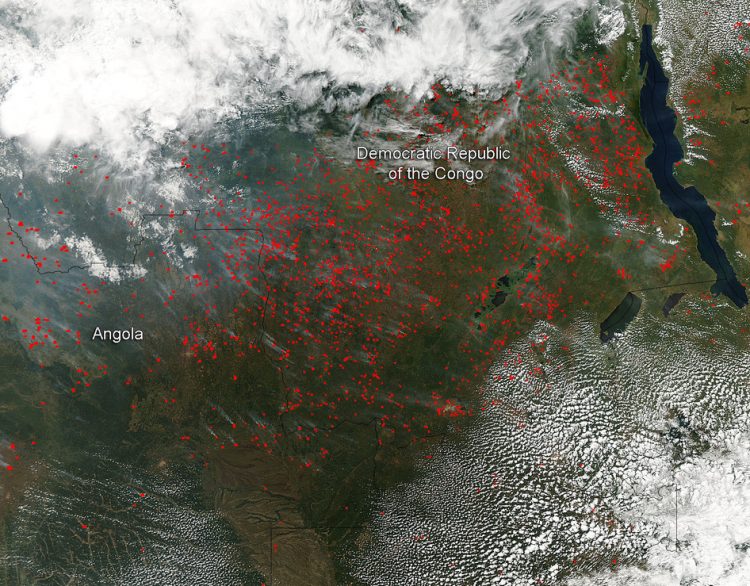Agricultural Fires Light Up Central Africa

MODIS detected hundreds of active fires (location marked in red) in the Democratic Republic of the Congo and northeastern Angola, a sign that the agricultural burning season is underway.
Agriculture is responsible for more than half of the products produced by the Democratic Republic of the Congo, and fire is a central feature in agriculture across most of Africa.
Places where traditional plots of open land are not available because the vegetation in the area is dense are the places where “slash and burn” agriculture is practiced most often.
These regions include parts of Africa, northern South America, and Southeast Asia, where an abundance of grasslands and rainforests are found. Farmers often use fire to return nutrients to the soil and to clear the ground of unwanted plants.
Fire is also used to drive game and grazing animals to new locations and to stimulate new growth in pastures. This annual burning has taken place for hundreds, possibly thousands of years, and it is not necessarily immediately hazardous.
But it can have a strong influence on air quality and public health, as well as on climate and natural resources.
NASA image courtesy Jeff Schmaltz LANCE/EOSDIS MODIS Rapid Response Team, GSFC. Caption by Lynn Jenner
Media Contact
All latest news from the category: Ecology, The Environment and Conservation
This complex theme deals primarily with interactions between organisms and the environmental factors that impact them, but to a greater extent between individual inanimate environmental factors.
innovations-report offers informative reports and articles on topics such as climate protection, landscape conservation, ecological systems, wildlife and nature parks and ecosystem efficiency and balance.
Newest articles

Superradiant atoms could push the boundaries of how precisely time can be measured
Superradiant atoms can help us measure time more precisely than ever. In a new study, researchers from the University of Copenhagen present a new method for measuring the time interval,…

Ion thermoelectric conversion devices for near room temperature
The electrode sheet of the thermoelectric device consists of ionic hydrogel, which is sandwiched between the electrodes to form, and the Prussian blue on the electrode undergoes a redox reaction…

Zap Energy achieves 37-million-degree temperatures in a compact device
New publication reports record electron temperatures for a small-scale, sheared-flow-stabilized Z-pinch fusion device. In the nine decades since humans first produced fusion reactions, only a few fusion technologies have demonstrated…





















